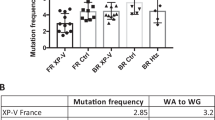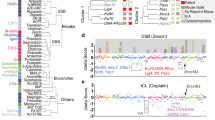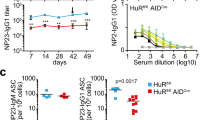Abstract
Somatic hypermutation of immunoglobulin genes is a unique, targeted, adaptive process. While B cells are engaged in germinal centres in T-dependent responses, single base substitutions are introduced in the expressed V h/V l genes to allow the selection of mutants with a higher affinity for the immunizing antigen. Almost every possible DNA transaction has been proposed to explain this process, but each of these models includes an error-prone DNA synthesis step that introduces the mutations1,2. The Y family of DNA polymerases3—pol η, pol ι, pol κ and rev1—are specialized for copying DNA lesions and have high rates of error when copying a normal DNA template4,5. By performing gene inactivation in a Burkitt's lymphoma cell line inducible for hypermutation, we show here that somatic hypermutation is dependent on DNA polymerase iota.
This is a preview of subscription content, access via your institution
Access options
Subscribe to this journal
Receive 51 print issues and online access
$199.00 per year
only $3.90 per issue
Buy this article
- Purchase on Springer Link
- Instant access to full article PDF
Prices may be subject to local taxes which are calculated during checkout


Similar content being viewed by others
References
Gearhart, P. J. & Wood, R. D. Emerging links between hypermutation of antibody genes and DNA polymerases. Nature Rev. Immunol. 1, 187–192 (2001)
Weill, J.-C. et al. Ig gene hypermutation: a mechanism is due. Adv. Immunol. 80, 183–202 (2002)
Ohmori, H. et al. The Y-family of DNA polymerases. Mol. Cell 8, 7–8 (2001)
Friedberg, E. C., Wagner, R. & Radman, M. Specialized DNA polymerases, cellular survival, and the genesis of mutations. Science 296, 1627–1630 (2002)
Goodman, M. F. Error-prone repair DNA polymerases in prokaryotes and eukaryotes. Annu. Rev. Biochem. 71, 17–50 (2002)
Sale, J. E. & Neuberger, M. S. TdT-accessible breaks are scattered over the immunoglobulin V domain in a constitutively hypermutating B cell line. Immunity 9, 859–869 (1998)
Denepoux, S. et al. Induction of somatic mutation in a human B cell line in vitro. Immunity 6, 35–46 (1997)
Zan, H. et al. Induction of Ig somatic hypermutation and class switching in a human monoclonal IgM+IgD+ B cell line in vitro: definition of the requirements and modalities of hypermutation. J. Immunol. 162, 3437–3447 (1999)
Faili, A. et al. AID-dependent somatic hypermutation occurs as a DNA single strand event in the BL2 cell line. Nature Immunol. 3, 815–821 (2002)
Muramatsu, M. et al. Class switch recombination and hypermutation require activation-induced cytidine deaminase (AID), a potential RNA editing enzyme. Cell 102, 553–563 (2000)
Revy, P. et al. Activation-induced cytidine deaminase (AID) deficiency causes the autosomal recessive form of the Hyper-IgM syndrome (HIGM2). Cell 102, 565–575 (2000)
Tissier, A., McDonald, J. P., Frank, E. G. & Woodgate, R. Pol iota, a remarkably error-prone human DNA polymerase. Genes Dev. 14, 1642–1650 (2000)
Frank, E. G. et al. Altered nucleotide misinsertion fidelity associated with pol iota-dependent replication at the end of a DNA template. EMBO J. 20, 2914–2922 (2001)
McDonald, J. P. et al. Novel human and mouse homologs of Saccharomyces cerevisiae DNA polymerase η. Genomics 60, 20–30 (1999)
Poltoratsky, V. et al. Expression of error-prone polymerases in BL2 cells activated for Ig somatic hypermutation. Proc. Natl Acad. Sci. USA 98, 7976–7981 (2001)
Zhang, W. et al. Clonal instability of V region hypermutation in the Ramos Burkitt's lymphoma cell line. Int. Immunol. 13, 975–984 (2001)
Bebenek, K. et al. 5′-Deoxyribose phosphate lyase activity of human DNA polymerase iota in vitro. Science 291, 2156–2159 (2001)
Petersen-Mahrt, S. K., Harris, R. S. & Neuberger, M. S. AID mutates E. coli suggesting a DNA deamination mechanism for antibody diversification. Nature 418, 99–103 (2002)
Papavasiliou, F. N. & Schatz, D. G. The activation-induced deaminase functions in a postcleavage step of the somatic hypermutation process. J. Exp. Med. 195, 993–998 (2002)
Zeng, X. et al. DNA polymerase eta is an A-T mutator in somatic hypermutation of immunoglobulin variable genes. Nature Immunol. 2, 537–541 (2001)
Rogozin, I. B., Pavlov, Y. I., Bebenek, K., Matsuda, T. & Kunkel, T. A. Somatic mutation hotspots correlate with DNA polymerase eta error spectrum. Nature Immunol. 2, 530–536 (2001)
Pavlov, Y. I. et al. Correlation of somatic hypermutation specificity and A-T base pair substitution errors by DNA polymerase η during copying of a mouse immunoglobulin κ light chain transgene. Proc. Natl Acad. Sci. USA 99, 9954–9959 (2002)
Dörner, T., Foster, S. J., Brezinschek, H.-P. & Lipsky, P. E. Analysis of the targeting of the hypermutational machinery and the impact of subsequent selection on the distribution of nucleotides changes in human VhDhJ rearrangements. Immunol. Rev. 162, 161–171 (1998)
Bachl, J. & Wabl, M. An immunoglobulin mutator that targets G.C base pairs. Proc. Natl Acad. Sci. USA 93, 851–855 (1996)
Zan, H. et al. The translesion DNA polymerase zeta plays a major role in Ig and bcl-6 somatic hypermutation. Immunity 14, 643–653 (2001)
Diaz, M., Verkoczy, L. K., Flajnik, M. F. & Klinman, N. R. Decreased frequency of somatic hypermutation and impaired affinity maturation but intact germinal center formation in mice expressing antisense RNA to DNA polymerase zeta. J. Immunol. 167, 327–335 (2001)
Johnson, R. E., Washington, M. T., Haracska, L., Prakash, S. & Prakash, L. Eukaryotic polymerases iota and zeta act sequentially to bypass DNA lesions. Nature 406, 1015–1019 (2000)
Mittrucker, H. W., Muller-Fleckenstein, I., Fleckenstein, B. & Fleischer, B. Herpes virus saimiri-transformed human T lymphocytes: normal functional phenotype and preserved T cell receptor signalling. Int. Immunol. 5, 985–990 (1993)
de Wind, N., Dekker, M., Berns, A., Radman, M. & te Riele, H. Inactivation of the mouse Msh2 gene results in mismatch repair deficiency, methylation tolerance, hyperrecombination, and predisposition to cancer. Cell 82, 321–330 (1995)
Acknowledgements
We thank B. Fleckenstein for the CB15 cell line; H. Mossafa for the cytogenetic analysis of pol-ι-null clones; R. Woodgate for pol-ι -specific reagents; M. Radman for critically editing the manuscript. This work was supported by the Fondation Princesse Grace de Monaco and the Ligue Nationale Française contre le Cancer (Equipe labellisée). A.F. and S.A. have been supported during part of this work by the Fondation de France (Fondation contre la Leucémie). C.-A.R. and J.-C.W. share senior authorship.
Author information
Authors and Affiliations
Corresponding author
Ethics declarations
Competing interests
The authors declare that they have no competing financial interests.
Supplementary information
Rights and permissions
About this article
Cite this article
Faili, A., Aoufouchi, S., Flatter, E. et al. Induction of somatic hypermutation in immunoglobulin genes is dependent on DNA polymerase iota. Nature 419, 944–947 (2002). https://doi.org/10.1038/nature01117
Received:
Accepted:
Issue Date:
DOI: https://doi.org/10.1038/nature01117
This article is cited by
-
Lamin B1 regulates somatic mutations and progression of B-cell malignancies
Leukemia (2018)
-
The error-prone DNA polymerase ι provides quantitative resistance to lung tumorigenesis and mutagenesis in mice
Oncogene (2014)
-
Tumor-initiating stem-like cells and drug resistance: carcinogenesis through Toll-like receptors, environmental factors, and virus
Drug Delivery and Translational Research (2013)
-
Identification of 15 new psoriasis susceptibility loci highlights the role of innate immunity
Nature Genetics (2012)
-
Y-family DNA polymerases in mammalian cells
Cellular and Molecular Life Sciences (2009)
Comments
By submitting a comment you agree to abide by our Terms and Community Guidelines. If you find something abusive or that does not comply with our terms or guidelines please flag it as inappropriate.



